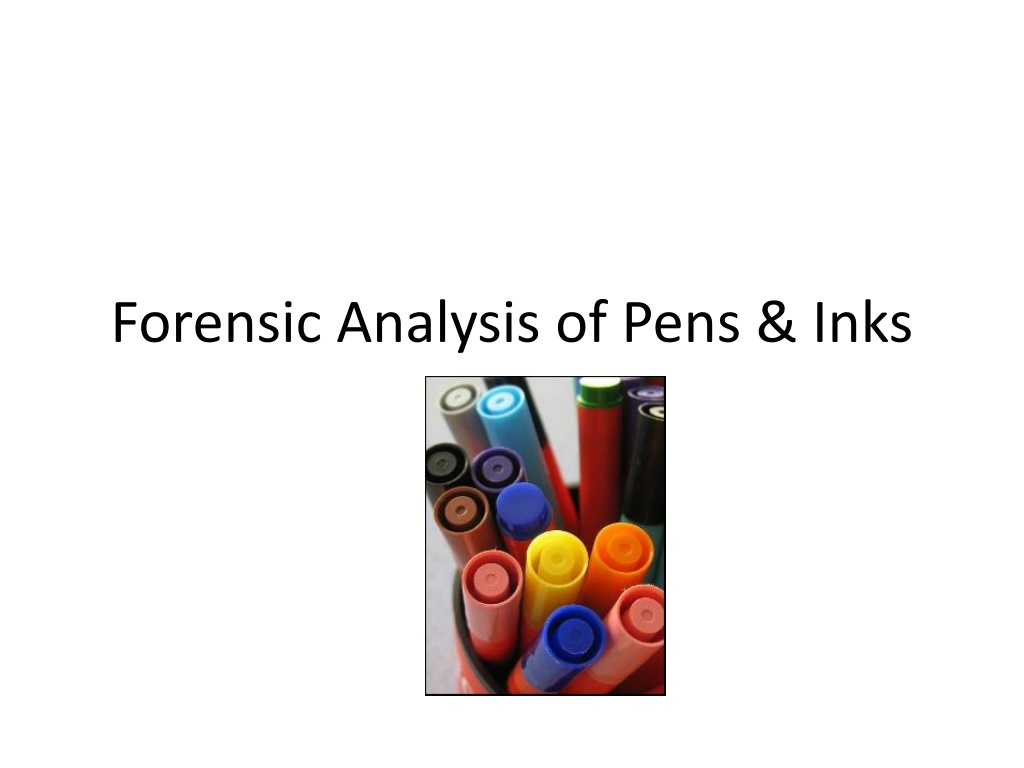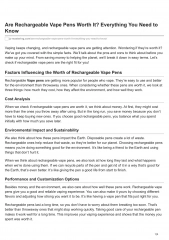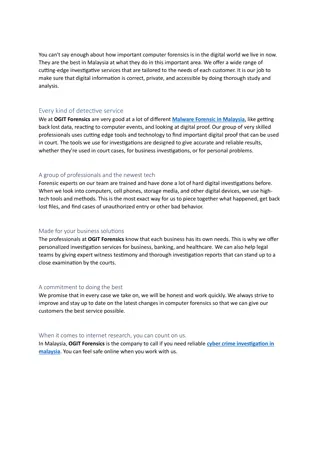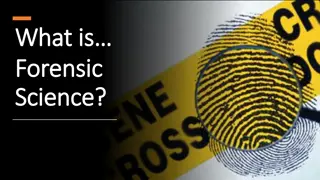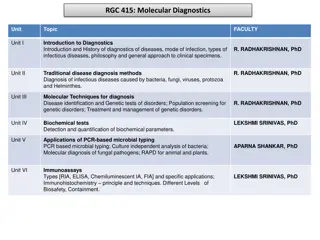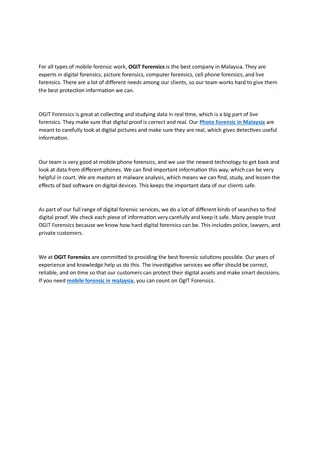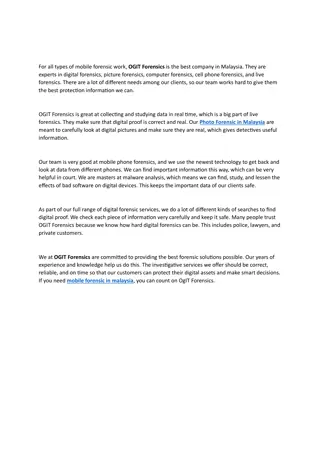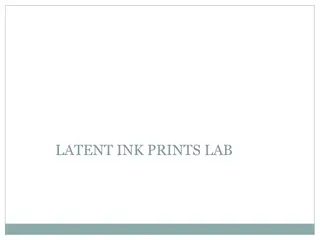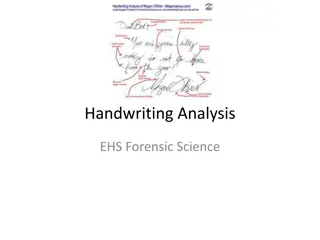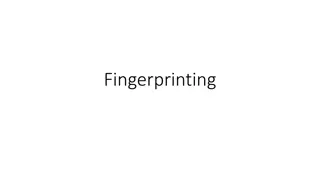Understanding Forensic Analysis of Pens & Inks
Explore the intricate world of forensic analysis of pens and inks, delving into ink composition, aging aspects, analytical techniques, and types of pens like ballpoint, rollerball, fountain, and gel pens. Discover how inks on questioned documents are examined and learn about the tools and methods used in ink analysis for identification purposes.
Download Presentation

Please find below an Image/Link to download the presentation.
The content on the website is provided AS IS for your information and personal use only. It may not be sold, licensed, or shared on other websites without obtaining consent from the author. Download presentation by click this link. If you encounter any issues during the download, it is possible that the publisher has removed the file from their server.
E N D
Presentation Transcript
Video link http://www.youtube.com/watch?v=I34tz5nIP Cs 9 min
Inks appearing on questioned documents may be examined for the purpose of comparing with other inks on the same document, with ink on other documents or even with ink in seized pens.
Aging is an important forensic aspect for ink analysis. If an old document has been altered recently, the newer ink will have a different composition to the old, aged ink and should be detectable by the appropriate technique
Inks Inks are complex mixtures of colorants, vehicles, and additives, which are adjusted in composition to produce the desired writing characteristics
Analytical Techniques Infrared, Mass Spectrometry, Gas Chromatography, and high-performance liquid chromatography, have been used to study different ink components for identification purposes
Types of Pens Ballpoint Rollerball Fountain Felt Ceramic tip Gel Tip
Ball Point Pen A ballpoint pen is a writing instrument which dispenses a viscous ink from an internal reservoir through the rolling action of a metal ball at its point. This "ball point" may vary in diameter, and may be made of brass, steel, or tungsten carbide
Roller Ball Pens use ball point writing mechanisms with water- based liquid or gelled ink, as opposed to the oil- based viscous inks found in ballpoint pens. These less viscous inks, which tend to saturate more deeply and more widely into paper than other types of ink, give roller ball pens their distinctive writing qualities. The writing point is a tiny ball, usually 0.5 or 0.7 mm in diameter, that transfers the ink from the reservoir onto the paper as the pen moves.
Gel Pens A gel pen uses ink in which pigment is suspended in a water-based gel. Because the ink is thick and opaque, it shows up more clearly on dark or slick surfaces than the typical inks used in ballpoint or felt tip pens.
Gel Pens The increasing popularity of gel pens has seen them used to sign many legal documents and as a direct result, they have also become the subject of forensic scrutiny in cases of suspected fraud Several well-established methods exist for analyzing inks from ballpoint and fountain pens, but not for inks from gel pens
Fountain Pen A fountain pen is a nib pen that, unlike its predecessor the dip pen, contains an internal reservoir of water-based liquid ink. The pen draws ink from the reservoir through a feed to the nib and deposits it on paper via a combination of gravity and capillary action.
Felt Pen A marker pen, marking pen, felt-tip pen, flow, marker is a pen which has its own ink-source, and usually a tip made of a porous, pressed fibers such as felt . Until the early 1990s the most common solvents that were used for the ink were toluene and xylene. Today, the ink is usually made on the basis of alcohols (e.g. propanol, butanol, diacetone alcohol and cresols
Ceramic Tip Pens wears well and does not broaden when pressure is applied while writing
Forensics Analysis of Ink Chromatography analysis
What is chromatography? Chromatography (from Greek word for chromosfor colour) is the collective term for a family of laboratory techniques for the separation of mixtures. It involves passing a mixture which contains the analyte through a stationary phase, which separates it from other molecules in the mixture and allows it to be isolated. Which means ... Chromatography is the physical separation of a mixture into its individual components. We can use chromatography to separate the components of inks and dyes, such as those found in pens, markers, clothing, and even candy shells. Chromatography can also be used to separate the colored pigments in plants or used to determine the chemicalcomposition of many substances. http://members.shaw.ca/vict/chemistry_test3.htm
Examples of Chromatography Liquid Chromatography Used to identify unknown plant pigments & other compounds. Thin-Layer Chromatography Uses thin plastic or glass trays to identify the composition of pigments, chemicals, and other unknown substances. Gas Chromatography Used to determine the chemical composition of unknown substances, such as the different compounds in gasoline shown by each separate peak in the graph below. Paper Chromatography Can be used to separate the components of inks, dyes, plant compounds (chlorophyll), make-up, and many other substances
Mixtures & Compounds Mixture Two or more substances that are mixed together, but not chemically combined. Examples of mixtures ... Air mixture of gases Bowl of cereal mixture of cereal and milk Soda pop mixture of soda syrup, water, and CO2 gas Fog water suspended in air Kool-Aid mixture of water, sugar, and flavor crystals Compounds Two or more elements that are chemically combined. Examples of compounds ... Salt Sodium and chlorine combined chemically Water Hydrogen and oxygen combined chemically Carbon Dioxide Carbon and oxygen combined chemically
Solutions Solutions are mixtures in which one substance is dissolved in another. Solutions have two parts: solute and solvent The solute is the substance that is dissolved. The solvent is the substance that does the dissolving Identify the solute and solvent in each solution ... Solution Solute Solvent Lemonade Soda pop Ocean water Solubility - A measure of how much of a given substance will dissolve in a liquid. A substance that does not dissolve in water is called insoluble. A substance that does dissolve in water is called soluble.
